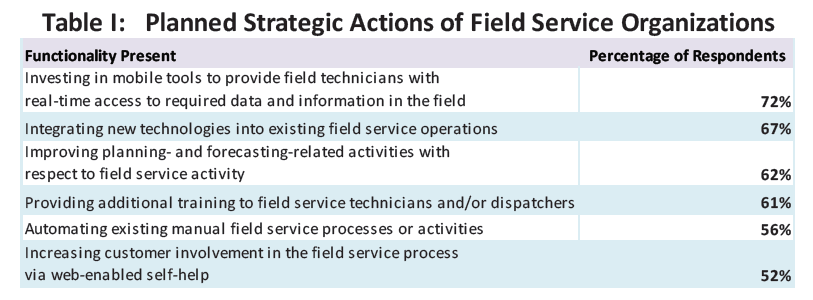So, you’re in the process of implementing a Mobile Workforce Management solution that will enable your company to deliver superior field service and customer satisfaction. After reading our post from two weeks ago, you have diligently spent time identifying the problems that need to be addressed through this solution, integrating the opinions and perspectives of various stakeholders in the company.
Now you’re ready for step 2: defining the various possible solutions.
As you begin to brainstorm potential solutions, you must continue to work with a plethora of relevant stakeholders and incorporate ideas across a spectrum of perspective. One type of solution that is increasingly common is found in the approach service organizations are taking with respect to planning and forecasting, training, automation, and increasing customer involvement. These are all elements of service that, if used effectively, can provide service organizations with everything needed to get the job done, all while reducing internal costs, generating higher levels of service revenue and profits, and keeping customers both satisfied and loyal. Recent research by the Service Council confirms both the importance and application of these key elements by identifying the following strategic actions being undertaken by a majority of service organizations with respect to improving their service performance:


These planned strategic actions are proof positive that the path to increased customer satisfaction, reduced costs, and a healthier bottom line is found by empowering those in the field while minimizing the time they need to be there. It is in management’s best interests to invest in tools that allow their field technicians to be self-reliant and to bring customer issues to resolution quickly. In that spirit, leading service organizations intend on supporting their field technicians with a variety of online capabilities, including providing access to real-time parts and inventory availability (43%), ability to track and update the current status of work orders (40%), access to customer/asset service history (40%), access to resolution scenarios (35%), and access to product schematics and documentation (34%).
At this point you have a list of problems and areas to improve upon, and each item on that list should have at least one “possible” solution (such as the ones above). Classify each of these solutions as one or more of the following:
- Organizational changes
- Process adjustments
- Technology implementation
Next, it is critical to evaluate each one of these potential solutions in terms of how they will affect various quantifiable metrics within field service performance. Survey findings reveal that there are six primary service performance metrics, or KPIs, presently being used by a majority of surveyed service organizations:
- Customer Satisfaction (70%)
- Service Revenue (66%)
- Service Profitability (59%)
- Field Technician Utilization (57%)
- On-site Response Time Performance (52%)
- Total Service Cost (50%)
However, there are an additional five KPIs that between one-third and one-half of the leading service organizations also use that help to distinguish them from all others.
These include:
- Mean-Time-to-Repair (MTTR) (49%)
- Service Level Agreement (SLA) Compliance (48%)
- First Time Fix Rate (45%)
- Field Technician Productivity (i.e., average number of calls per day) (41%)
- Customer Retention (36%)
While all service organizations report some reliance on a number of specific KPIs, the leading organizations may use up to twice as many to monitor their performance on an ongoing basis. Therefore, a significant portion of this discussion should be about management’s capabilities as they relate to the detection of problems and measuring success of solutions. This will be critical to determine the ROI of your whichever solution your choose.
About Uniphore: Uniphore Technologies Inc is the leader in Multi lingual speech-based software solutions. Uniphore’s solutions allow any machine to understand and respond to natural human speech, thus enabling humans to use the most natural of communication modes, speech, to engage and instruct machines. Uniphore operates from its corporate headquarters at IIT Madras Research Park, Chennai, India and has sales offices in Middle East (Dubai, UAE) as well as in Manila, Philippines.
